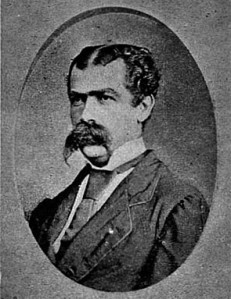The Paraíba Inscription
While the Kensington Runestone undoubtedly exists, the same cannot be said for the so-called Paraíba (or Parahyba) Inscription, for which the sole evidence is a transcription accompanying a letter sent to Cândido José de Araújo Viana (1793-1875), the Visconde (later Marqués) de Sapucahy, President of the Instituto Histórico e Geográfico Brasiliero in Rio de Janeiro (Brazil) in 1872, who passed it to Ladislau de Souza Mello Netto
(1838-94). Although Netto was a botanist, he was also the interim
director of the Museum Nacional and had a knowledge of Punic archaeology
and the Hebrew language. The following year, the discovery was reported
by the newly formed London Anthropological Society in Anthropologia (1, 208) in a letter sent by A F Jones from Rio de Janeiro, who said that “[t]he published accounts of this find are so vague and unscientific that I can form no opinion of my own about it”.
At a meeting of the Society on 6 January 1874, three translations were
compared and there was considerable discussion about its authenticity;
on the 11 August 1874, A F Jones wrote again to the Society, saying that
Ernest Renan (1823-1892), the Semiticist, considered it a hoax. Other experts in Semitic languages, including Konstantin Schlottmann (1819-1887) and Julius Euting (1839-1913) were also of the opinion that the supposed inscription was a fake.
In the meantime, Netto had tried to
locate the original inscription. The letter writer was one Joaquim Alves
da Costa, a plantation owner from a place named Pouso Alto, near
Paraíba; several places called Pouso Alto were found, while two places
named Paraíba are known (one in the province of the same name, the other
near Rio de Janeiro). Alves da Costa and his estate proved impossible
to locate and Netto concluded that the whole affair was nothing more
than a hoax, publishing a report as Lettre
à Monsieur Ernest Renan à propos de l’Inscription Phénicienne Apocryphe
soumise en 1872 à l’Institut historique, géographiqe et ethnographique
du Brésil (“Letter to M Ernest Renan concerning the fake
Phoenician inscription submitted in 1872 to the Historical, Geographical
and Ethnographic Institute of Brazil”) in 1885. Netto blamed the hoax
on foreigners who were trying to discredit Brazilian scientists and
although he claimed to know the identity of the hoaxer, declined to
reveal it.
However, the story was revived more than
eighty years after Netto’s debunking work was published in 1885, when
Jules Piccus (1920-1997), professor of Romance languages at the
University of Massachusetts (Amherst, USA), bought a scrapbook at a
jumble sale in Providence (Rhode Island, USA) in 1967. It contained
correspondence sent by Netto to Wilberforce Eames
(1855-1937), a librarian at New York Public Library, which included a
copy of the alleged inscription and a translation made by Netto in 1874.
Piccus, who seems to have been unaware of Netto’s 1885 report, sent a
copy to Cyrus Herzl Gordon
(1909-2001), head of the Department of Mediterranean Studies at
Brandeis University in Waltham (Massachusetts, USA) and an expert in
ancient Semitic languages. Unlike Renan, he thought the Paraíba
inscription contained elements of Phoenician style that were unknown in
the nineteenth century and concluded that it was genuine.
Gordon was quick to release the story to the media, with a report appearing in The New York Times by the science writer Walter Seager Sullivan (1918-1996) that was widely syndicated to other newspapers, and a sensational report by A Douglas Matthews in Life.
This is a tactic widely used by pseudoscientists and regarded with
suspicion by scholars. Despite Gordon’s certainty about the genuineness
of the inscription, he failed to find support from other linguists. He
conducted a long and acrimonious dispute with Frank Moore Cross Jr
(born 1921), Hancock Professor of Hebrew and Other Oriental Languages
Emeritus at Harvard. Cross was scathing in his criticisms of Gordon,
pointing to problems with the script, vocabulary and spelling. Gordon
continued to champion this text and others as evidence for numerous
transaltantic contacts in Antiquity but failed to convince sceptics.
Like the Kensington Runestone, the
Paraíba Inscription was quickly denounced by linguists, subsequently to
be revived by those claiming that its peculiarities could be explained
by more recent discoveries that would have been unknown to a
nineteenth-century hoaxer. Unlike the Runestone, though, there is no
artefact to examine, no physical evidence and not even an accepted
findspot. It has all the hallmarks of a crude fraud.
Si direbbe che i falsari abbiano imparato molto anch'essi da questo episodio. L'esclusione dalla considerazione scientifica di ciò che non è prodotto in originale all'osservazione sembra essere l'unica efficace difesa.
Se Parahibo ha così tanto in comune con Tzricottu, Gordon con chi si potrebbe accomunare, amico mio?
So che hai in mente qualche nome: è solo questione di Tempo.

